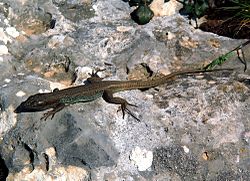Order: Squamata (lizards, snakes, and amphisbaenians)

Suborder: Amphisbaenia (amphisbaenians)
- Family: Amphisbaenidae
- Genus: Blanus
- Turkish worm lizard, Blanus strauchi LC IUCN
- Genus: Blanus
Suborder: Lacertilia (lizards)










- Family: Agamidae
- Genus: Stellagama
- Starred agama, Laudakia stellio LC IUCN
- Genus: Stellagama
- Family: Anguidae
- Genus: Anguis
- Peloponnese slow worm, Anguis cephallonica NT IUCN (endemic)
- Slow worm, Anguis fragilis LC IUCN
- Greek slow worm, Anguis graeca LC IUCN
- Genus: Pseudopus
- European glass lizard, Pseudopus apodus LC IUCN
- Genus: Anguis
- Family: Chamaeleonidae
- Genus: Chamaeleo
- African chameleon, Chamaeleo africanus LC IUCN
- Mediterranean chameleon, Chamaeleo chamaeleon LC IUCN
- Genus: Chamaeleo
- Family: Gekkonidae
- Genus: Hemidactylus
- Turkish gecko, Hemidactylus turcicus LC IUCN
- Genus: Mediodactylus
- Barton's thin-toed gecko, Mediodactylus bartoni LC IUCN (endemic)
- Mediterranean thin-toed gecko, Mediodactylus danilewskii (NR)
- Kotschy's gecko, Mediodactylus kotschyi LC IUCN
- Oertzen's thin-toed gecko, Mediodactylus oertzeni LC IUCN (endemic)
- Eastern Mediterranean thin-toed gecko, Mediodactylus orientalis (NR)
- Genus: Tarentola
- Common wall gecko, Tarentola mauritanica LC IUCN
- Genus: Hemidactylus
- Family: Lacertidae
- Genus: Algyroides
- Greek algyroides, Algyroides moreoticus NT IUCN (endemic)
- Dalmatian algyroides, Algyroides nigropunctatus LC IUCN
- Genus: Anatololacerta
- Anatolian rock lizard, Anatololacerta anatolica LC IUCN
- Budak's rock lizard, Anatololacerta finikensis (NR)
- Pelasgian rock lizard, Anatololacerta pelasgiana LC IUCN
- Genus: Darevskia
- Meadow lizard, Darevskia praticola NT IUCN
- Genus: Hellenolacerta
- Greek rock lizard, Hellenolacerta graeca LC IUCN (endemic)
- Genus: Lacerta
- Sand lizard, Lacerta agilis LC IUCN
- Balkan green lizard, Lacerta trilineata LC IUCN
- European green lizard, Lacerta viridis LC IUCN
- Genus: Ophisops
- Snake-eyed lizard, Ophisops elegans LC IUCN
- Genus: Podarcis
- Cretan wall lizard, Podarcis cretensis LC IUCN (endemic)
- Erhard's wall lizard, Podarcis erhardii LC IUCN
- Skyros wall lizard, Podarcis gaigeae VU IUCN (endemic)
- Ionian wall lizard, Podarcis ionicus LC IUCN
- Pori wall lizard, Podarcis levendis VU IUCN (endemic)
- Milos wall lizard, Podarcis milensis VU IUCN (endemic)
- Common wall lizard, Podarcis muralis LC IUCN
- Peloponnese wall lizard, Podarcis peloponnesiacus LC IUCN (endemic)
- Italian wall lizard, Podarcis siculus LC IUCN
- Balkan wall lizard, Podarcis tauricus LC IUCN
- Andalusian wall lizard, Podarcis vaucheri LC IUCN
- Genus: Zootoca
- Viviparous lizard, Zootoca vivipara LC IUCN
- Genus: Algyroides
- Family: Scincidae
- Genus: Ablepharus
- Juniper skink, Ablepharus kitaibelii LC IUCN
- Genus: Chalcides
- Ocellated skink, Chalcides ocellatus LC IUCN
- Genus: Heremites
- Levant skink, Heremites auratus LC IUCN
- Genus: Ophiomorus
- Anatolian limbless skink, Ophiomorus kardesi (NR)
- Greek snake skink, Ophiomorus punctatissimus LC IUCN (endemic)
- Genus: Ablepharus
Suborder: Serpentes (snakes)

- Family: Colubridae
- Genus: Coronella
- Smooth snake, Coronella austriaca LC IUCN
- Genus: Dolichophis
- Caspian whipsnake, Dolichophis caspius LC IUCN
- Black whipsnake, Dolichophis jugularis LC IUCN
- Genus: Eirenis
- Dwarf snake, Eirenis modestus LC IUCN
- Genus: Elaphe
- Four-lined snake, Elaphe quatuorlineata LC IUCN
- Blotched snake, Elaphe sauromates LC IUCN
- Genus: Hierophis
- Balkan whip snake, Hierophis gemonensis LC IUCN
- Green whip snake, Hierophis viridiflavus LC IUCN
- Genus: Hemorrhois
- Coin-marked snake, Hemorrhois nummifer LC IUCN
- Genus: Malpolon
- Eastern Montpellier snake, Malpolon insignitus LC IUCN
- Genus: Natrix
- Grass snake, Natrix natrix LC IUCN
- Dice snake, Natrix tessellata LC IUCN
- Genus: Platyceps
- Slender whipsnake, Platyceps najadum LC IUCN
- Genus: Telescopus
- European cat snake, Telescopus fallax LC IUCN
- Genus: Zamenis
- Aesculapian ratsnake, Zamenis longissima LC IUCN
- European ratsnake, Zamenis situla LC IUCN
- Genus: Coronella
- Family: Boidae
- Genus: Eryx
- Javelin sand boa, Eryx jaculus LC IUCN
- Genus: Eryx
- Family: Typhlopidae
- Genus: Xerotyphlops
- Eurasian blind snake, Xerotyphlops vermicularis LC IUCN
- Genus: Xerotyphlops
- Family: Viperidae
- Genus: Macrovipera
- Cyclades blunt-nosed viper, Macrovipera schweizeri EN IUCN (endemic)
- Genus: Montivipera
- Rock viper, Montivipera xanthina LC IUCN
- Genus: Vipera
- Long-nosed viper, Vipera ammodytes LC IUCN
- Adder, Vipera berus LC IUCN
- Greek meadow viper, Vipera graeca EN IUCN
- Genus: Macrovipera

